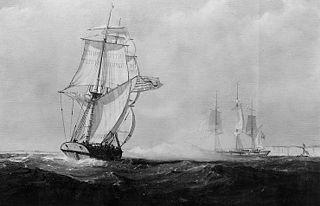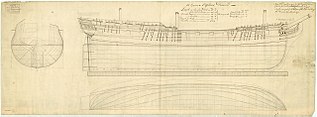
The second USS Revenge was a cutter in the Continental Navy and later a privateer.

HMS Raisonnable was a 64-gun third-rate ship of the line of the Royal Navy, named after the ship of the same name captured from the French in 1758. She was built at Chatham Dockyard, launched on 10 December 1768 and commissioned on 17 November 1770 under the command of Captain Maurice Suckling, Horatio Nelson's uncle. Raisonnable was built to the same lines as HMS Ardent, and was one of the seven ships forming the Ardent class of 1761. Raisonnable was the first ship in which Nelson served.

HMS Orpheus was a British Modified Lowestoffe-class fifth-rate frigate, ordered on 25 December 1770, as one of five fifth-rate frigates of 32 guns each contained in the emergency frigate-building programme inaugurated when the likelihood of war with Spain arose over the ownership of the Falkland Islands. Sir Thomas Slade's design for Lowestoffe was approved, but was revised to produce a more rounded midships section; the amended design was approved on 3 January 1771 by Edward Hawke's outgoing Admiralty Board, just before it was replaced. The contract to build the Orpheus was awarded to John Barnard at Harwich, the keel being laid in May 1771, and the frigate was launched 7 May 1773, at a cost of £12,654.16.11d. She sailed from Harwich on 24 May for Sheerness Dockyard, where she was completed and fitted out to the Navy Board's needs by 11 June.

HMS St Albans was a 64-gun third rate ship of the line of the Royal Navy, launched on 12 September 1764 by Perry, Wells & Green at their Blackwall Yard, London.

HMS Badger was a brig rigged Sloop-of-War in service with the Royal Navy in the late eighteenth century. Badger is notable as being the first Royal Navy ship to be commanded by Horatio Nelson.

HMS Ambuscade was a 32-gun fifth-rate frigate of the Royal Navy, built in the Grove Street shipyard of Adams & Barnard at Depford in 1773. The French captured her in 1798 but the British recaptured her in 1803. She was broken up in 1810.
HMS Glasgow was a 20-gun sixth-rate post ship of the Royal Navy. She was launched in 1757 and took part in the American Revolutionary War. While under command of Capt. William Maltby she ran onto rocks at Cohasset, Massachusetts on 10 December 1774. Refloated and arrived in Boston on the 15th for repairs. Capt. Maltby was relieved of command at a Court Martial and replaced by Tyringham Howe some time between 8–15 January 1775. She is most famous for her encounter with the maiden voyage of the Continental Navy off Block Island on 6 April 1776. In that action, Glasgow engaged a squadron of 6 ships of the Continental Navy, managing to escape intact. Under the command of Tho. Pasley, she captured sloop Juliana on 1 April 1777. She captured sloop Unity on 2 April 1777. She captured the sloop Betsy & Ann on 4 April. She captured sloop Volante on 5 April. She captured the brig Aurora on 10 April. She captured sloop Sally on 16 April. She captured American privateer sloop Henry on 19 April. She captured schooner Providence on 2 May. She captured schooner Nancy, probably in early May. She captured schooner Betsy 27 June. She captured brig Dolphin on unknown date. She captured sloop Rover on 24 July. She captured sloop Antonio on 21 July. She captured sloop Tryall on 25 July. She captured an unknown schooner on an unknown date. She captured schooner Gen. Thompson on an unknown date. She captured sloop Industry at an unknown date. She captured schooner Betsy & Ann on 4 November. She captured brig Sally on 8 December. She captured sloop Defiance and schooner Success on 9 December. She captured brig Minerva on 19 December. She captured schooner Happy Return on 22 December 1777. On 28 February 1778, she captured sloop Abigale 5 leagues east northeast of the Tiburon Peninsula. On 9 March 1778, she captured schooner Nancy 6 leagues off Mayaguana, Bahamas. She captured sloop Lucy on 12 March off the south east end of Mayaguana. She captured a prize in April 1778, but it sprang a leak and sank.

HMS Lowestoffe was a 32-gun fifth-rate frigate of the Royal Navy. Built during the latter part of the Seven Years' War, she went on to see action in the American War of Independence and the French Revolutionary War, and served often in the Caribbean. A young Horatio Nelson served aboard her shortly after passing his lieutenant's examination.

HMS Winchelsea was a 32-gun fifth-rate Niger-class frigate of the Royal Navy, and was the sixth Royal Navy ship to bear this name. She was ordered during the Seven Years' War, but completed too late for that conflict. She cost £11,515-18-0d to build.

HMS Carysfort was a 28-gun Coventry-class sixth-rate frigate of the Royal Navy. She served during the American War of Independence, the French Revolutionary and the Napoleonic Wars in a career that spanned over forty years.

Tyrannicide was a 14-gun brigantine-rigged sloop of the Massachusetts State Navy. The ship was built for the American Revolutionary War and participated in commerce raiding until destroyed in the Penobscot expedition.
HMS Greyhound was a modified Royal Navy Mermaid-class sixth-rate frigate. She was first commissioned in October 1775 under Captain Archibald Dickson.
HMS Boreas was a modified Mermaid-class sixth-rate frigate of the Royal Navy. She was first commissioned in August 1775 under Captain Charles Thompson. She was built at Blaydes Yard in Hull to a design by Sir Thomas Slade at a cost of £10,000. She was fitted out at Chatham Docks.

HMS Juno was a 32-gun Richmond-class fifth-rate frigate of the Royal Navy. She was launched in 1757 and served throughout the American Revolutionary War until scuttled in 1778 to avoid capture. On 5 June, 1777 she, HMS Juno, and HMS Orpheus recaptured privateer brig "Lucy" 15 Leagues off Nantucket. On 9 July, 1777 she captured Betsy in Boston Bay. On 9 January, 1778 she captured French snow David 3-4 miles off the north east tip of Block Island. She engaged USS Providence during Providence's escape from Providence, Rhode Island 30 April 1778.

HMS Milford was a 28-gun Coventry-class sixth-rate frigate of the Royal Navy. She was built at Milford by Richard Chitty and launched in 1759. She was sold for breaking at Woolwich on 17 May 1785.
HMS Galatea was a 20-gun Sphinx-class sixth-rate post-ship of the Royal Navy. She was designed by John Williams and built by Adam Hayes in Deptford Dockyard, being launched on 21 March 1776. She served during the American War of Independence.

HMS Ceres was an 18-gun sloop launched in 1777 for the British Royal Navy that the French captured in December 1778 off Saint Lucia. The French Navy took her into service as Cérès. The British recaptured her in 1782 and renamed her HMS Raven, only to have the French recapture her again early in 1783. The French returned her name to Cérès, and she then served in the French Navy until sold at Brest in 1791.

Experiment was a 50-gun ship of the line of the British Royal Navy. Captured by Sagittaire during the War of American Independence, she was recommissioned in the French Navy, where she served into the 1800s.

HMS Glory was a 32-gun fifth-rate Niger-class frigate of the Royal Navy, and was the second Royal Navy ship to bear this name.

HMS Aeolus (1758) was a 32-gun fifth-rate frigate of the Royal Navy. In 1800, she renamed as HMS Guernsey.















